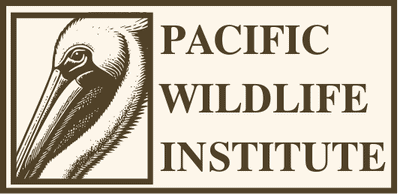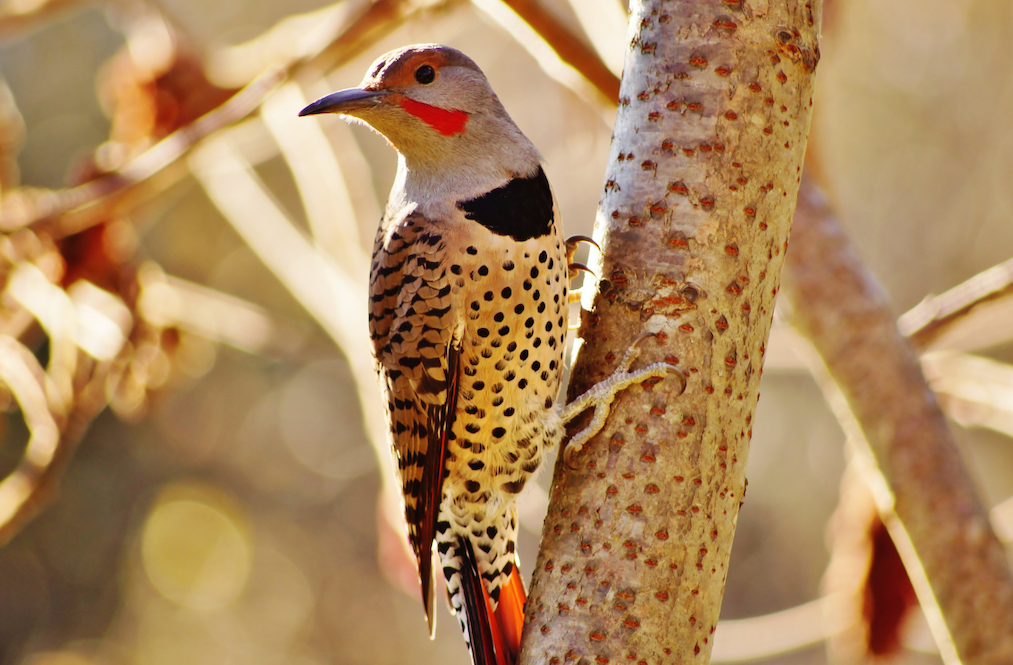Scientific Name: Colaptes auratus
– Family: Picidae
– Order: Piciformes
Common Names
– Northern Flicker
– Yellowhammer (nickname in some regions)
Description
The Northern Flicker is a large, brown woodpecker, notable for its vibrant plumage and distinctive behavior. It measures approximately 12 to 14 inches in length with a wingspan of 17 to 21 inches. The bird’s back is tan with black barring, and it has a black bib under the throat. Variations include the “Yellow-shafted” flicker in the east, which has yellow underwings and tail feathers, and the “Red-shafted” flicker in the west, with red underwings and tail feathers. Both sexes have a prominent white rump patch that is visible in flight, but males can be distinguished by a black or red mustache mark.
Distribution and Habitat
Northern Flickers are found across North America, from Alaska to Central America, adapting to a variety of habitats including forests, woodlands, savannas, and suburban areas. They are one of the few woodpecker species that migrate, with birds in the northern parts of their range moving south for the winter.
Behavior
Unlike most woodpeckers, Northern Flickers often feed on the ground, primarily hunting for ants and beetles. Their flight is distinctive, consisting of a rhythmic pattern of a few flaps followed by a glide. These birds are known for their loud call, which sounds like a loud “wick-wick-wick,” and during the spring, they perform impressive courtship dances, which include head bobbing, tail spreading, and wing flashing.
Diet
Their diet is unusually varied for a woodpecker. While they primarily consume insects, especially ants and beetles, they also eat fruits and seeds. During the winter months, their diet shifts more towards fruit, which they can digest more readily than many other woodpecker species.
Reproductive Information
Northern Flickers typically nest in tree cavities they excavate in dead or diseased wood. They can also reuse cavities from previous years or take over nests created by other species. The female lays 6 to 8 eggs, which both parents incubate for about 11 to 12 days. The chicks are altricial (born blind and featherless) and remain in the nest for about 25 to 28 days, with both parents sharing feeding duties.
Conservation Status
The Northern Flicker is classified as Least Concern by the IUCN, although its populations are declining in some areas due to habitat loss and competition for nesting sites. Conservation efforts focus on preserving woodland habitats and managing forests in ways that retain dead trees for nesting.
Ecological Role
As a primary excavator of nesting cavities, which are also used by other species, Northern Flickers play a crucial role in their ecosystems. Their diet helps control populations of ants and other insects, contributing to the ecological balance.
Research and Observation
Studies on Northern Flickers have explored their diet preferences, migratory behaviors, and the ecological impact of their feeding habits. Recent research has also examined the effects of urbanization on their breeding success and survival rates.
Management Strategies
Efforts to support Northern Flicker populations include promoting the conservation of mature forests with ample dead wood, implementing policies that restrict the removal of dead trees, and providing artificial nesting boxes to supplement natural cavity availability.
How to Attract Northern Flickers to Your Property
1. Preserve Dead Trees: Keeping dead or dying trees on your property can provide natural nesting sites for Northern Flickers.
2. Offer Nesting Boxes: If natural cavities are scarce, installing large birdhouses designed for woodpeckers can attract flickers.
3. Maintain a Chemical-Free Environment: Avoiding pesticides helps ensure a healthy insect population for flickers to feed on.
4. Plant Native Berry-Producing Shrubs: Including native plants that produce berries can provide a food source during the winter months when insects are scarce.
5. Provide a Dust Bath: Northern Flickers often take dust baths, so providing a sandy area or a shallow pit can make your property more inviting.
By creating a habitat that caters to the Northern Flicker’s nesting, feeding, and behavioral needs, you can encourage these fascinating birds to visit or reside in your area.
Click “Buy a Nestbox” below to start making your property a suitable habitat for Northern Flickers!


